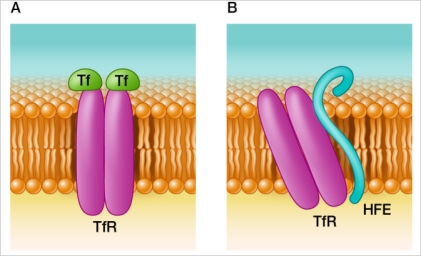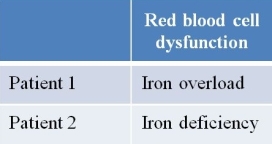Refer to the figures and table below. 
 Human blood cell membranes import iron into the cell via receptor-mediated endocytosis.They do this using transferrin receptors to bind the iron-carrier protein transferrin, which carries two Fe3+ ions per protein molecule.Panel A of the figure above shows two transferrin molecules (Tf) bound to one receptor (TfR) .Panel B shows the interaction between the regulatory protein HFE and the transferrin receptor, which results in inhibition of transferrin binding to the transferrin receptor.Genetic mutations in transferrin, transferrin receptor, or HFE can lead to red blood cell dysfunctions.How might mutations be involved in the two cases summarized in the table?
Human blood cell membranes import iron into the cell via receptor-mediated endocytosis.They do this using transferrin receptors to bind the iron-carrier protein transferrin, which carries two Fe3+ ions per protein molecule.Panel A of the figure above shows two transferrin molecules (Tf) bound to one receptor (TfR) .Panel B shows the interaction between the regulatory protein HFE and the transferrin receptor, which results in inhibition of transferrin binding to the transferrin receptor.Genetic mutations in transferrin, transferrin receptor, or HFE can lead to red blood cell dysfunctions.How might mutations be involved in the two cases summarized in the table?
A) Patient 1 has a mutation in the transferrin gene that disrupts its ability to bind iron, and patient 2 has a mutation in the transferrin receptor gene that prevents it from binding transferrin.
B) Patient 1 has a mutation in the transferrin receptor gene that prevents it from binding transferrin, and patient 2 has a mutation in the HFE gene that prevents it from binding to the transferrin receptor.
C) Patient 1 has a mutation in the HFE gene that prevents it from binding to the transferrin receptor, and patient 2 has a mutation in the transferrin receptor gene that prevents it from binding HFE.
D) Patient 1 has a mutation in the transferrin gene that disrupts its ability to bind iron, and patient 2 has a mutation in the transferrin gene that prevents it from binding to the transferrin receptor.
E) Patient 1 has a mutation in the HFE gene that prevents it from binding to the transferrin receptor, and patient 2 has a mutation in the transferrin receptor gene that prevents it from binding transferrin.
Correct Answer:
Verified
Q196: If an animal cell needs to acquire
Q197: Which experimental observation would provide evidence that
Q198: Aquaporins are membrane channels that are highly
Q199: Many animal cells have a sodium-potassium pump
Q200: There are two basic types of active
Q202: Refer to the figure below. 
Q203: Refer to the table below. 
Q204: Persons with the inherited disease familial hypercholesterolemia
Q205: Refer to the figure below. 
Q206: In animal cells, which process does not
Unlock this Answer For Free Now!
View this answer and more for free by performing one of the following actions

Scan the QR code to install the App and get 2 free unlocks

Unlock quizzes for free by uploading documents